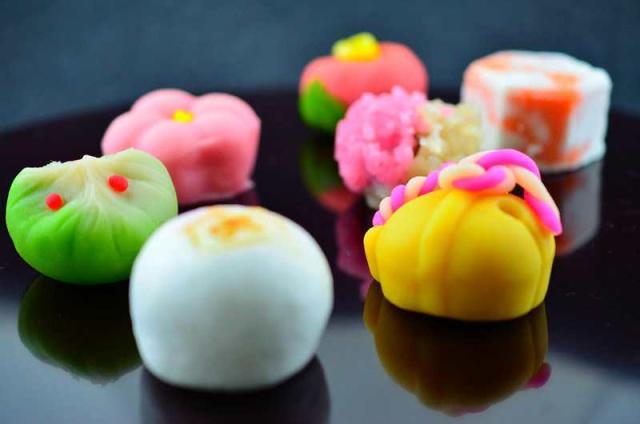4 best Japanese traditional snacks and sweets
There are variety of traditional sweets in Japan
Japanese people started to develop wagashi (和菓子) culture since 7th century when Japan started to trade with China. Since then Japanese people kept on developing wagashi. Unlike yo-gashi (洋菓子: Western Sweet), wagashi does not usually use milk or cream. Wagashi tends to use Wasanbon sugar (和三盆) and other Japanese-origin ingredients.
As time comes closer to today, the variety of Japanese snack increased such as Senbei (rice cookie).
In this article, I would like to introduce you best 4 Japanese traditional sweets!
As time comes closer to today, the variety of Japanese snack increased such as Senbei (rice cookie).
In this article, I would like to introduce you best 4 Japanese traditional sweets!
1. Nerikiri / 練りきり
Nerikiri is a kind of Wagashi.
How to make nerikiri.
1: Mix white bean jam and sugar.
2: Add Rice flour and and Japanese mountain yam.
3. Process the shape.
Nerikiri is often used for tea ceremony, therefore, they usually have such an elaborated design peculiar to each wagashi shop.
How to make nerikiri.
1: Mix white bean jam and sugar.
2: Add Rice flour and and Japanese mountain yam.
3. Process the shape.
Nerikiri is often used for tea ceremony, therefore, they usually have such an elaborated design peculiar to each wagashi shop.
2. Dorayaki / どら焼き
Dorayaki (どら焼き, どらやき, 銅鑼焼き, ドラ焼き?) is a type of Japanese confection, а red-bean pancake which consists of two small pancake-like patties made from castella wrapped around a filling of sweet Azuki red bean paste.[1][2] Dorayaki are similar to Imagawayaki, but the latter are cooked with the batter completely surrounding the bean paste filling and are often served hot.
The original Dorayaki consisted of only one layer. Its current shape was invented in 1914 by Usagiya in the Ueno district of Tokyo.[3]
In Japanese, dora means "gong", and because of the similarity of the shapes, this is probably the origin of the name of the sweet.[2][3] Legend has it that the first Dorayaki were made when a samurai named Benkei forgot his gong (dora) upon leaving a farmer’s home where he was hiding and the farmer subsequently used the gong to fry the pancakes, thus the name Dorayaki.[3]
The original Dorayaki consisted of only one layer. Its current shape was invented in 1914 by Usagiya in the Ueno district of Tokyo.[3]
In Japanese, dora means "gong", and because of the similarity of the shapes, this is probably the origin of the name of the sweet.[2][3] Legend has it that the first Dorayaki were made when a samurai named Benkei forgot his gong (dora) upon leaving a farmer’s home where he was hiding and the farmer subsequently used the gong to fry the pancakes, thus the name Dorayaki.[3]
Source: Wikipedia
Dorayaki is famous for Doraemon rather than itself.
The points of dorayaki are the taste of red-bean pancake and Azuki bean paste.
Expensive dorayaki usually pays close attention to the quality of red-bean and Azuki bean.
My recommendation of dorayaki is this Seijuken wagashi shop.
The points of dorayaki are the taste of red-bean pancake and Azuki bean paste.
Expensive dorayaki usually pays close attention to the quality of red-bean and Azuki bean.
My recommendation of dorayaki is this Seijuken wagashi shop.
どら焼きは東京が発祥の地。都内には感動で涙が止まらなくなるような絶品のどら焼きを提供するお店がたくさんあるのです!ここでは、どら焼き好きなら絶対一度は食べておきたい絶品どら焼きがあるお店を「10」店ご紹介しますよ。
3. Senbei / せんべい (煎餅)
Senbei (煎餅?, alternatively spelled sembei) are a type of Japanese rice crackers. They come in various shapes, sizes, and flavors, usually savory but sometimes sweet. Senbei are often eaten with green tea as a casual snack and offered to visiting house guests as a courtesy refreshment.
Source: Wikipedia
Senbei has a history more than 1000 years, however current senbei started with Soka senbei (草加せんべい), which became famous at Edo era.
Usually, senbei is hard rice cracker. However, soft wet senbei is becoming more and more famous recently.
Therefore you must be careful that senbei does not always mean a hard cracker.
Here is a website for the most famous senbei, "Soka senbei".
Usually, senbei is hard rice cracker. However, soft wet senbei is becoming more and more famous recently.
Therefore you must be careful that senbei does not always mean a hard cracker.
Here is a website for the most famous senbei, "Soka senbei".
4. Manjū / 饅頭
Manjū (饅頭?, まんじゅう) is a popular traditional Japanese confection. There are many varieties of manjū, but most have an outside made from flour, rice powder and buckwheat and a filling of anko (red bean paste), made from boiled azuki beans and sugar. They are boiled together again and kneaded. There are several varieties of bean paste used including koshian, tsubuan, and tsubushian.
Source: Wikipedia
Japanese Manju uses red bean paste as a filling. However the origin of Manju did not use red bean paste.
In 1349, Chinese monk migrated to Japan carrying manju culture with him. However at that time, meat paste was used as a filling because Chinese buddhism did not prohibit monks from eating meat. However, Japanese buddhism prohibited monks from eating any meat, therefore Japanese people started to use red bean paste as a filling.
Original manju with meat filling is called 肉まん (Nikuman) now.
There are 3 most major shops of manju in Japan.
"志ほせ饅頭" (Shiose Manju)
In 1349, Chinese monk migrated to Japan carrying manju culture with him. However at that time, meat paste was used as a filling because Chinese buddhism did not prohibit monks from eating meat. However, Japanese buddhism prohibited monks from eating any meat, therefore Japanese people started to use red bean paste as a filling.
Original manju with meat filling is called 肉まん (Nikuman) now.
There are 3 most major shops of manju in Japan.
"志ほせ饅頭" (Shiose Manju)
塩瀬総本家のお饅頭です。「塩瀬」自慢の一口薯蕷饅頭、七代目林宗二創案の本饅頭、またさまざまなお祝いの席にご利用いただける紅白饅頭などがございます。
"大手まんじゅう" (Ohte Manju)
大手饅頭伊部屋の岡山備前銘菓【大手まんぢゅう】は天保8年に創業。その名称は、当店が岡山城大手門附近にあったため、備前藩主池田候からいただいたと伝えられています。以来その親しみやすい名前と風味豊かな味わいで備前名物としてご好評をいただいてまいりました。当店は、この伝統の味を失わぬよう努力致しております。贈答などに是非ご利用ください。
"柏屋薄皮まんじゅう" (Kashiwaya Usukawa Manju)
創業嘉永五年(1852年)柏屋薄皮饅頭。まごころを包んで160余年。東北福島の代表銘菓。北海道産小豆の自家製餡。日本三大饅頭に選ばれました。
Of course, there are many kinds of manju all over Japan other than these 3 famous manju.
I can safely say, wherever you travel in Japan, you will find local speciality manju.
I can safely say, wherever you travel in Japan, you will find local speciality manju.
Share
More Matome
Tuesday, December 02, 2025 at 15:58
27 view
Tuesday, December 02, 2025 at 15:57
28 view



.jpg)






























